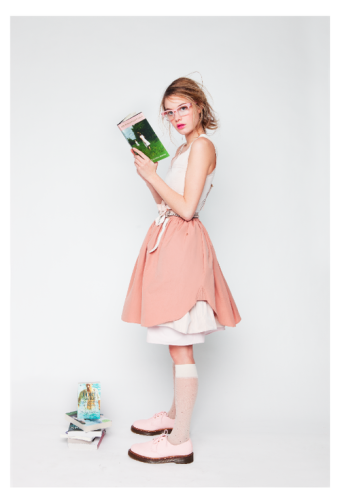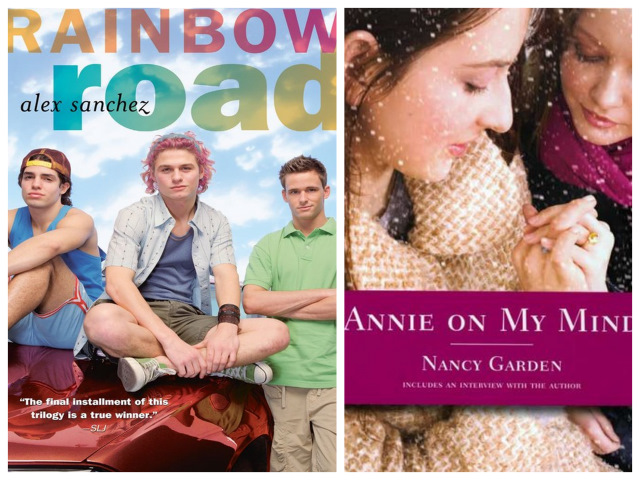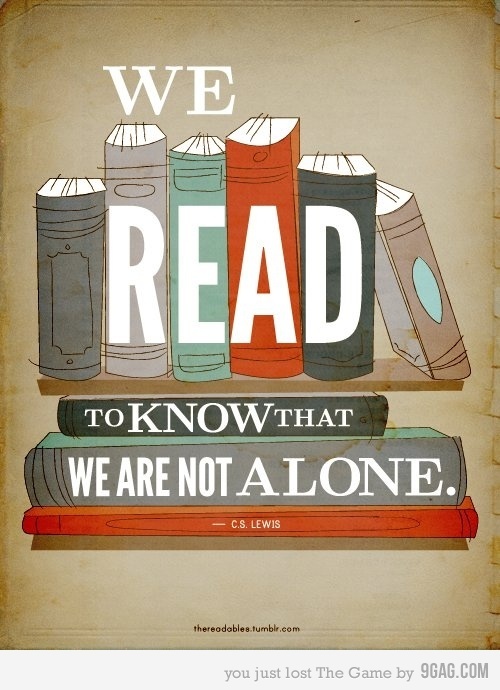 ETA: This post has been updated at 2pm PST to reflect new information regarding the veracity of The Publisher’s Weekly piece.
ETA: This post has been updated at 2pm PST to reflect new information regarding the veracity of The Publisher’s Weekly piece.
Once upon a time I lived in New York City and worked at a literary agency where I read a lot of query letters and manuscript submissions. Most of them sucked. We even made a Query Letter Drinking Game to quantify and celebrate the myriad of ways in which a manuscript was capable of sucking.
Consequently, there were lots of reasons to reject a proposal or request a complete overhaul. But “too gay” was never one of them.
So, I was surprised to read in Publisher’s Weekly about two YA novelists (Rachel Manija Brown and Sherwood Smith) who’d been told by a prospective agent that s/he’d take on their manuscript “on the condition that we make the gay character straight, or else remove his viewpoint and all references to his sexual orientation.”
Brown and Smith were, unsurprisingly, unimpressed with the offer:
Rachel replied, “Making a gay character straight is a line in the sand which I will not cross. That is a moral issue. I work with teenagers, and some of them are gay. They never get to read fantasy novels where people like them are the heroes, and that’s not right.”
The agent suggested that perhaps, if the book was very popular and sequels were demanded, Yuki could be revealed to be gay in later books, when readers were already invested in the series.
We knew this was a pie-in-the-sky offer—who knew if there would even be sequels?—and didn’t solve the moral issue. When you refuse to allow major characters in YA novels to be gay, you are telling gay teenagers that they are so utterly horrible that people like them can’t even be allowed to exist in fiction.
The authors go on to say that this was not an isolated incident, that other agents had similar reactions.
Any gay person working in media or entertainment might wonder what all the fuss is about — the fact that People With Money don’t think they can sell Our Gay Art is simply a fundamental truth of the creative industries we work in. Your lesbian screenplay remains far more likely to find support on Kickstarter than at The William Morris Agency and gay actors are still told that remaining closeted is necessary to advance their career. As a freelance writer, I got a taste of the journalism industry’s inherent fear of queer content and as CEO of a lesbian website, I’ve ingested an all-you-can eat Old Country Buffet of that ish.
But we expect more from books, don’t we? Due to a number of factors including low overhead, books have always been where minority groups have a voice — they may be hard to find, but they’re out there. Movies need millions of viewers to earn out, books can get by on mere tens of thousands.
Furthermore, Young Adult fiction, generally defined as fiction written for or marketed towards kids between the ages of 12 and 20, is notorious for pushing the boundaries of social acceptability and tackling controversial issues like cutting, drug abuse, incest, teen pregnancy and, of course, homosexuality.

In 1982, young budding lesbians were treated to Nancy Garden‘s oft-censored legendary lesbian YA novel Annie on my Mind, which featured not only a physical and emotional lesbian relationship between two teenage girls, but also a happy ending. It took twenty more years for a primetime television series to feature its first lesbian high school character — Evan Rachel Wood as Jessie on Once and Again. Presently it’s remarkably easy to find a gay teenager on television — Degrassi, Glee, Pretty Little Liars, Skins, 90210 — but that’s a very very recent phenomenon. In fact, the legendary Chuck Bass was gay in the Gossip Girl books and from what I’ve heard of the show, that element of his character never made the full transition from page to stage.
Needless to say, Smith & Brown’s case seems out of step with visible industry trends and my own anecdotal experiences.
I talked to Foundry Media Literary Agent Stephen Barbara, who represents leading YA authors including Lauren Oliver and Lisa Graff, about the PW piece. He pointed out: “It is actually quite fascinating to see the YA world attacked as a stronghold of mainstream conformity when only recently, Megan Cox Gurdon in the Wall Street Journal famously (or infamously) decried YA novels as “So dark that kidnapping and pederasty and incest and brutal beatings are now just part of the run of things.”
Of course, there’s a difference between controversial material and diversity (although LGBT characters are lucky enough to come up in conversations about both) to which Barbara posits: “Are the same editors who publish such edgy material also systematically forcing their authors to make their characters white, straight, and non-disabled? It’s a good question, perhaps more asserted than proved, and it would be interesting if someone were to find an objective way to answer it.”
Pointing out that it’s difficult to draw conclusions from a piece that’s “anecdotal rather than statistics-based,” Barbara told me: “If there is systemic effort to make all YA “straight white,” we should see it reflected in the books published each year. Yet the same article at PW links to a page with a long list of major authors with LGBTQ characters and themes in their novels, and the comments section of the page is full of supportive stories from agents and writers who, encouragingly, have sold or are selling books which do not fit a ‘straight white mold.’”
Malinda Lo, award-winning YA novelist and co-founder of the Diversity in YA blog, didn’t have any trouble selling her lesbian YA novel, Ash, a lesbian take on the Cinderella story: “Commercial publishing in the United States is so gay-friendly it’s practically Gay Utopia. I mean, children’s book editors are, frankly, notoriously liberal! (Or else, open secret, they’re gay!) And they live and work in New York City, which is second only to San Francisco in Gay Utopicness.”
But to see how typical or atypical her experience was, Lo did some number-crunching after reading the Publisher’s Weekly post, and what she found wasn’t great or terrible.
Lo’s graph of the LGBT YA novels published every year from 1969 ’til 2011:

(Sidenote: Due to the two-year publishing cycle, the 2010 downturn is almost certainly a result of the 2008 economic crash)
However, Lo points out that relative to the entire YA market (and its ambiguous numbers), LGBT YA still accounts for less than 1% of the marketplace. To be fair, the percentage of Young Adults identifying as LGBT is probably not much higher.

Literary Agent Cameron McClure of the Donald Maas Literary Agency represents LGBT material by authors including me, John Pitts, Brian Francis Slattery and Elizabeth Sims. She says that “in the adult world, selling gay and lesbians hasn’t been an issue for me. I have an urban fantasy series that features a sword wielding lesbian blacksmith, and a few SFF [Science Fiction/Fantasy] novels that have male gay protagonists, and an old lesbian crime series.”
Brown & Smith’s YA novel was a Sci-Fi/Fantasy post-apocalyptic novel, and McClure notes that at least for adults, “the SFF genre is generally more open to this material than mainstream publishing.”
It’s clear that book publishing is not inherently an unfriendly space, but perhaps it’s just as susceptible to market pressures as other forms of media. Ultimately, it would be irresponsible and counterintuitive for an agent to take on a book s/he knew s/he was unable to sell.
As McClure points out: “YA publishers do have legitimate sales reasons for not publishing books with LGBTQ characters. Agents know this, and know that finding a publisher for this material is harder, and the economy sucks, and everyone just wants to eat and be able to buy shit, so sure, there are going to be agents and other “gatekeepers” who don’t want to bother with this material. Because it will be harder to sell and will sell for less money.”
McClure added that this is true for any minority character, not just LGBTQs. As described in How To Make YA Fiction More Diverse, from The Atlantic Monthly: “Conventional wisdom assumes that white kids won’t pick up a book that has a picture of a person of color on the cover, and there have been controversial incidents of YA covers being “whitewashed” in recent years.”
The LGBTQ minority has some specific challenges, too — many libraries/bookstores won’t stock LGBT YA books, and when much of your target audience is hiding their identity from friends & family, it’s hard to pave a direct route to their wallets or nightstands.

Brown & Smith‘s story has now been picked up by tons of LGBT websites as well as The Guardian UK. Needless to say, the story has now made its way to the desk of the unnamed agency in question.
Joanna Stampfel-Volpe works at Nancy Coffey Literary & Media Representation, and says the experience described in the PW piece is “completely untrue... we never asked that the authors change any LGBTQ character to a straight character.” (I recommend you read her entire post explaining what happened, as well as this post from another agent who passed on the manuscript in question for reasons unrelated to sexual orientation.)
She goes on to say:
One of our agents is being used as a springboard for these authors to gain attention for their project. She is being exploited. But even worse, by basing their entire article on untruths, these authors have exploited the topic. By doing that, they’ve chipped away at the validity of the resulting conversation.
And it’s a conversation that should be had.
So let’s continue this conversation, and let’s base it on the truth, which is:
There are not enough mainstream books that depict characters of diverse race, sexual orientation, religious beliefs, and physical and/or mental disabilities.
+
Regardless of veracity, the conversation has indeed begun, and perhaps there’s still time for it to be redirected. Gay teens are more visible on television than ever before, and a large reason for that is how vocal the LGBT community has been about needing that representation. Can we make the same change for LGBT literature? I think we can.
I predict, based on nothing besides my own psychic instincts, we’re going to see the numbers of LGBT-identifying high schoolers skyrocket over the next five years and this is a huge opportunity for the LGBT YA market.
Despite Lo’s conclusion that only 25% of LGBT YA books were about girls, I’ve personally found tracking down lesbian themes in YA fiction relatively easy, and there are several websites dedicated to the genre, including Daisy Porter‘s Queer YA and Lee Wind‘s I’m Here, I’m Queer, What the Hell Do I Read? which was very useful for Laneia and I when we put together our two-part series on lesbian young adult fiction for this website.

In another reaction piece to the Brown & Smith debacle, gay YA author Scott Tracey suggests:
If you want more books with LGBT content, buy the ones that are already out there. Show publishers that there’s profit to be made by investing in these books.
I’d add to that to seek out especially books with female protagonists or lead characters. Although we’ve done several features on LGBT YA books already, I’m going to make a concerted effort to amp up that coverage on this website, especially YA novels featuring women of color.
So, all you young adults and appreciators of young adult fiction — buy that shit! Brittany/Santana fan-fic is not the only way to get your literary lesbian on. Here’s a starter list:
Young Adult Fiction
+ Annie on My Mind, by Nancy Garden
+ Keeping You a Secret, by Julie Anne Peters
+ Down to the Bone, by Mayra Lazara Dole
+ Gravel Queen, by Tea Benduhn
+ Empress of the World, by Sara Ryan
+ Ash, by Malinda Lo
+ Pages for You: A Novel, by Sylvia Brownrigg
+ Girl Walking Backwards, by Bett Williams
Happy reading!







